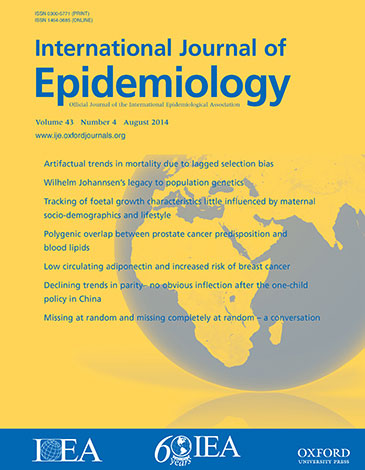Probabilistic bias analysis for exposure misclassification of household income by neighbourhood in a cohort of individuals with colorectal cancer.
IF 6.4
2区 医学
Q1 PUBLIC, ENVIRONMENTAL & OCCUPATIONAL HEALTH
引用次数: 0
Abstract
INTRODUCTION Despite poor agreement, neighbourhood income is used as a proxy for household income, due to a lack of data availability. We quantified misclassification between household and neighbourhood income and demonstrate quantitative bias analysis (QBA) in scenarios where only neighbourhood income is available in assessing income inequalities on colorectal cancer mortality. METHODS This was a retrospective study of adults with colorectal cancer diagnosed 2006-14 from Statistics Canada's Canadian Census Health and Environment Cohort. Neighbourhood income quintiles from Statistics Canada were used. Census household income quintiles were used to determine bias parameters and confirm results of the QBA. We calculated positive and negative predictive values using multinomial models, adjusting for age, sex and rural residence. Probabilistic QBA was conducted to explore the implication of exposure misclassification when estimating the effect of income on 5-year mortality. RESULTS We found poor agreement between neighbourhood and household income: positive predictive values ranged from 21% to 37%. The bias-adjusted risk of neighbourhood income on 5-year mortality was similar to the risk of mortality by household income. The bias-adjusted relative risk of the lowest income quintile compared with the highest was 1.42 [95% simulation interval (SI) 1.32-1.53] compared with 1.46 [95% confidence interval (CI) 1.39-1.54] for household income and 1.18 (95% CI 1.12-1.24) for neighbourhood income. CONCLUSION QBA can be used to estimate adjusted effects of neighbourhood income on mortality which represent household income. The predictive values from our study can be applied to similar cohorts with only neighbourhood income to estimate the effects of household income on cancer mortality.对结肠直肠癌患者队列中按社区划分的家庭收入暴露误分类进行概率偏差分析。
简介:尽管一致性较差,但由于缺乏可用数据,邻里收入仍被用作家庭收入的替代物。在评估结直肠癌死亡率的收入不平等时,我们量化了家庭收入和邻里收入之间的误分类,并展示了在仅有邻里收入的情况下的定量偏差分析(QBA)。方法这是一项回顾性研究,研究对象是2006-14年间确诊患有结直肠癌的成年人,他们来自加拿大统计局的加拿大人口普查健康与环境队列。研究使用了加拿大统计局的邻里收入五分法。普查家庭收入五分法用于确定偏差参数和确认 QBA 的结果。我们使用多项式模型计算了阳性和阴性预测值,并对年龄、性别和农村居住地进行了调整。在估计收入对 5 年死亡率的影响时,我们进行了概率 QBA,以探讨暴露误分类的影响。结果我们发现邻里关系和家庭收入之间的一致性很差:阳性预测值从 21% 到 37% 不等。经偏差调整的邻里收入对 5 年死亡率的影响风险与家庭收入对死亡率的影响风险相似。与最高收入五分位数相比,最低收入五分位数的偏差调整相对风险为 1.42 [95% 模拟区间 (SI) 1.32-1.53],而家庭收入的偏差调整相对风险为 1.46 [95% 置信区间 (CI) 1.39-1.54],邻里收入的偏差调整相对风险为 1.18 (95% CI 1.12-1.24)。我们的研究得出的预测值可用于仅有邻里收入的类似队列,以估计家庭收入对癌症死亡率的影响。
本文章由计算机程序翻译,如有差异,请以英文原文为准。
求助全文
约1分钟内获得全文
求助全文
来源期刊

International journal of epidemiology
医学-公共卫生、环境卫生与职业卫生
CiteScore
13.60
自引率
2.60%
发文量
226
审稿时长
3 months
期刊介绍:
The International Journal of Epidemiology is a vital resource for individuals seeking to stay updated on the latest advancements and emerging trends in the field of epidemiology worldwide.
The journal fosters communication among researchers, educators, and practitioners involved in the study, teaching, and application of epidemiology pertaining to both communicable and non-communicable diseases. It also includes research on health services and medical care.
Furthermore, the journal presents new methodologies in epidemiology and statistics, catering to professionals working in social and preventive medicine. Published six times a year, the International Journal of Epidemiology provides a comprehensive platform for the analysis of data.
Overall, this journal is an indispensable tool for staying informed and connected within the dynamic realm of epidemiology.
 求助内容:
求助内容: 应助结果提醒方式:
应助结果提醒方式:


